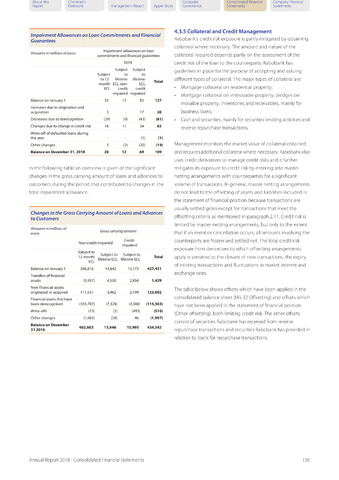About this
Report
Chairman's
Foreword
Corporate
Management Report Appendices Governance
Consolidated Financial Company Financial
Statements Statements
Impairment Allowances on Loan Commitments and Financial
Guarantees
Amounts in millions of euros
Impairment allowances on loan
commitments and financial guarantees
2018
Subject Subject
Subject to to
to 12- lifetime lifetime
month ECL non- ECL
ECL credit credit
impaired impaired
Total
Balance on January 1
Increases due to origination and
acquisition
Decreases due to derecognition
Changes due to change in credit risk
Write-off of defaulted loans during
the year
Other changes
Balance on December 31, 2018
33
3
(29)
18
3
28
12
(9)
11
(2)
12
82
17
(43)
34
(1)
(20)
69
127
20
(81)
63
(1)
(19)
109
In the following table an overview is given of the significant
changes in the gross carrying amount of loans and advances to
customers during the period that contributed to changes in the
total impairment allowance.
Changes in the Gross Carrying Amount of Loans and Advances
to Customers
Amounts in millions of
euros
Gross carrying amount
Non-credit-
•impaired
Credit-
impaired
Subject to
12-month
ECL
Subject to
lifetime ECL
Subject to
lifetime ECL
Total
Balance on January 1
396,816
14,842
15,773
427,431
Transfers of financial
assets
(5,957)
4,530
2,856
1,429
New financial assets
originated or acquired
117,531
3,962
2,199
123,692
Financial assets that have
been derecognised
(103,787)
(7,328)
(4,388)
(115,503)
Write-offs
(15)
(2)
(493)
(510)
Other changes
(1,985)
(58)
46
(1,997)
Balance on December
31 2018
402,603
15,946
15,993
434,542
4.3.5 Collateral and Credit Management
Rabobank's credit risk exposure is partly mitigated by obtaining
collateral where necessary. The amount and nature of the
collateral required depends partly on the assessment of the
credit risk of the loan to the counterparty. Rabobank has
guidelines in place forthe purpose of accepting and valuing
different types of collateral. The major types of collateral are:
Mortgage collateral on residential property;
Mortgage collateral on immovable property, pledges on
movable property, inventories and receivables, mainly for
business loans;
Cash and securities, mainly for securities lending activitiesand
reverse repurchase transactions.
Management monitors the market value of collateral obtained
and requiresadditional collateral where necessary. Rabobankalso
uses credit derivatives to manage credit risks and it further
mitigates its exposure to credit risk by entering into master
netting arrangements with counterparties for a significant
volume of transactions. In general, master netting arrangements
do not lead to the offsetting of assets and liabilities included in
the statement of financial position because transactions are
usually settled gross except for transactions that meet the
offsetting criteria as mentioned in paragraph 2.11Credit risk is
limited by master netting arrangements, but only to the extent
that if an event or cancellation occurs, all amounts involving the
counterparty are frozen and settled net. The total credit risk
exposure from derivatives to which offsetting arrangements
apply is sensitive to the closure of new transactions, the expiry
of existing transactions and fluctuations in market interest and
exchange rates.
The table below shows offsets which have been applied in the
consolidated balance sheet (IAS 32 Offsetting) and offsets which
have not been applied in the statement of financial position
(Other offsetting), both limiting credit risk. The other offsets
consist of securities Rabobank has received from reverse
repurchase transactions and securities Rabobank has provided in
relation to loans for repurchase transactions.
Annual Report 2018 - Consolidated Financial Statements
156

